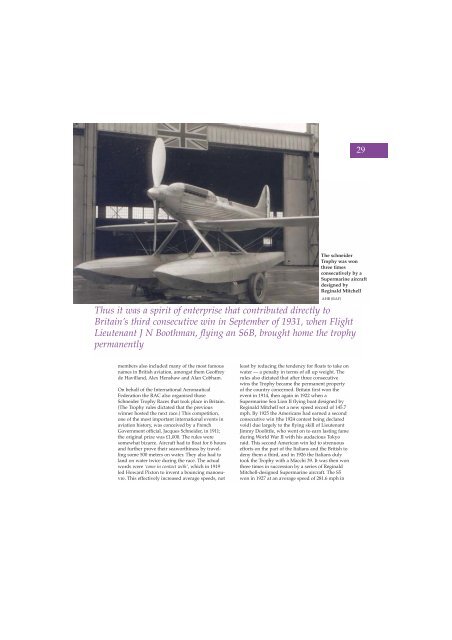Volume 6 No 4 - Royal Air Force Centre for Air Power Studies
Volume 6 No 4 - Royal Air Force Centre for Air Power Studies
Volume 6 No 4 - Royal Air Force Centre for Air Power Studies
You also want an ePaper? Increase the reach of your titles
YUMPU automatically turns print PDFs into web optimized ePapers that Google loves.
29<br />
The schneider<br />
Trophy was won<br />
three times<br />
consecutively by a<br />
Supermarine aircraft<br />
designed by<br />
Reginald Mitchell<br />
AHB (RAF)<br />
Thus it was a spirit of enterprise that contributed directly to<br />
Britain’s third consecutive win in September of 1931, when Flight<br />
Lieutenant J N Boothman, flying an S6B, brought home the trophy<br />
permanently<br />
members also included many of the most famous<br />
names in British aviation, amongst them Geoffrey<br />
de Havilland, Alex Henshaw and Alan Cobham.<br />
On behalf of the International Aeronautical<br />
Federation the RAC also organised those<br />
Schneider Trophy Races that took place in Britain.<br />
(The Trophy rules dictated that the previous<br />
winner hosted the next race.) This competition,<br />
one of the most important international events in<br />
aviation history, was conceived by a French<br />
Government official, Jacques Schneider, in 1911;<br />
the original prize was £1,000. The rules were<br />
somewhat bizarre. <strong>Air</strong>craft had to float <strong>for</strong> 6 hours<br />
and further prove their seaworthiness by travelling<br />
some 500 meters on water. They also had to<br />
land on water twice during the race. The actual<br />
words were ‘come in contact with’, which in 1919<br />
led Howard Pixton to invent a bouncing manoeuvre.<br />
This effectively increased average speeds, not<br />
least by reducing the tendency <strong>for</strong> floats to take on<br />
water — a penalty in terms of all up weight. The<br />
rules also dictated that after three consecutive<br />
wins the Trophy became the permanent property<br />
of the country concerned. Britain first won the<br />
event in 1914, then again in 1922 when a<br />
Supermarine Sea Lion II flying boat designed by<br />
Reginald Mitchell set a new speed record of 145.7<br />
mph. By 1925 the Americans had earned a second<br />
consecutive win (the 1924 contest being declared<br />
void) due largely to the flying skill of Lieutenant<br />
Jimmy Doolittle, who went on to earn lasting fame<br />
during World War II with his audacious Tokyo<br />
raid. This second American win led to strenuous<br />
ef<strong>for</strong>ts on the part of the Italians and the British to<br />
deny them a third, and in 1926 the Italians duly<br />
took the Trophy with a Macchi 39. It was then won<br />
three times in succession by a series of Reginald<br />
Mitchell-designed Supermarine aircraft. The S5<br />
won in 1927 at an average speed of 281.6 mph in
















